Development and Displacement in West Bengal: An Excerpt from a Forthcoming Paper
By Abhijit Guha, Reader, Dept. of Anthropology, V.U.
General Scenario
The first striking thing one observes in this field is the virtual absence of any empirical and theoretical work on development induced displacement in West Bengal. This of course does not mean that displacement and rehabilitation are non-existent in West Bengal, which in the pre-Independence period, was the leading state in terms of industrialisation, and where, after Independence, large industries and thermal power plants have been built up displacing many families (including tribals) from their agricultural land and homes. West Bengal has also experienced large-scale mining on the western part of the state bordering Jharkhand.
In an article published in 1989, Walter Fernandes and his co-workers, quoting from Government sources, have shown that for the Durgapur Steel Plant
in Bardhaman district of West Bengal 6,633.44 hectares of land was acquired, which displaced 11,300 persons, 3.39 percent of whom were tribals (Fernandes et al. 1989). In the same article, Fernandes quoted another Government source which showed that up to 1983 there were 114 mines (all are coal mines) in West Bengal although he did not give any concrete figure about the total number of displaced persons owing to the acquisition of land for the establishment of mines. Through extrapolation, Fernandes, however, arrived at an estimate of 1,380 displaced persons per mine in India which brings out a figure of 1,57,320 persons in case of West Bengal.
In more recent period, particularly since the adoption of a liberalised economic policy by the Central Government, quite a good number of development projects have been launched by the West Bengal Government and many more will be coming up in near future. The building up of a new township near Kolkata and the establishment of industries in the rural areas of West Bengal including a port centered industrial complex at Haldia in the Purba Medinipur district constitute the recent development package of the Government of West Bengal. For the successful implementation of this development policy large scale acquisition of land has already been taken place in West Bengal, which displaced quite a good number of small and marginal farmers.
No published statistics on displaced (DP) and project affected persons (PAP), let alone their caste/tribe affiliation, are available from any official source of Government of West Bengal. Displacement and rehabilitation have not yet entered into the official agenda of the Government of West Bengal like the routinised recording of bargadars (sharecroppers) and the number of landless labourers who have been given land by the Government.
On the other hand, the West Bengal scenario is yet to figure in any substantial manner in the academic literature with respect to land acquisition,
development induced displacement and rehabilitation. There exist at least four special volumes of important Indian journals devoted exclusively to displacement and rehabilitation, but none of them contain any case study or policy-oriented paper on West Bengal. These journals are Social Action (Vol. 45, No. 3, 1995, July – Sept.), Lokayan Bulletin (Vol. 11, No. 5, 1995), Economic and Political Weekly (Vol. XXXI, No. 24, June 1996) and Eastern Anthropologist (Vol. 53, Nos. 1-2, January-June 2000).
The same is true about recently published monographs viz., Development Displacement and Rehabilitation edited by Walter Fernandes and Enakshi
Ganguly Thukral (1989), The Uprooted (1990) edited by V. Sudarsen and M.A. Kalam and Development Projects and Impoverishment Risks edited by Hari Mohan Mathur and David Marsden (2000).
Very recently, Partha Chatterjee, a renowned political scientist, has undertaken a study on resettlement and rehabilitation in West Bengal. His paper, which is still unpublished was presented in a workshop on “Social Development Research” in West Bengal held during 6-7 July 2000 at the Centre for Studies in Social Sciences, Kolkata.
In this significant paper, Chatterjee has pointed out that participatory rehabilitation through NGOs has become a “mantra” which is being repeated by the Governments, funding agencies, experts and activists but “little attention has been given to the specific forms of practice through which appropriate and adequate ‘participation’ can be ensured” (Chatterjee 2000). Chatterjee used three cases of displacement and consequent rehabilitation in West Bengal to assess the role of the political parties’ vis-à-vis Government bureaucracy in providing rehabilitation to PAP in West Bengal. His findings on the political processes that centered around the rehabilitation mechanisms of the recent industrialisation in Haldia (1988-91) and the
establishment of new township in Rajarhat clearly demonstrated the dominance of the local political society over the Government administration. Quite interestingly, in both the cases, the distribution of rehabilitation benefits was based on a ground-level agreement between the representatives of the ruling and the opposition political parties of West Bengal. The net result of this process was the distribution of a better and quicker rehabilitation package to the project affected families than it would have been made by the usual land acquisition procedure carried out by the bureaucratic machinery alone. In West Bengal, it was the political society (represented by the political parties) rather than the civil society (represented by the NGOs), which took the role of a mediator between the state and the PAP. Field based empirical accounts of development caused displacement in West Bengal was published for the first time by the author of this article in journals based on a case study in erstwhile Medinipur district (Guha 2004a). Land Acquisition in West Bengal : Legal Developmental and Policy Dimensions
Land acquisition in West Bengal has a special significance in the context of the pro-peasant land reform policies adopted and implemented by the Left
Front Government in West Bengal since it came to power in 1977. Almost all the studies conducted by the researchers on displacement in other states of India did not take into consideration the dampening effects of land acquisition on small peasants and sharecroppers who are the real beneficiaries of land reforms.
Agricultural land is not only a socio-cultural and economic category for the peasants in a rural setting but the rights of the people over such land
depend on the functioning of a specific set of legal, administrative and policy apparatus with which a particular state power is endowed in a given period of time. The functioning of the legal, administrative and policy apparatus of the state power do not again operate in a cultural vacuum. The differing and sometimes quite opposing perspectives on issues around development form the cultural context within which the state apparatus functions.
According to the Land Acquisition Act, the state can exercise its right of eminent domain wherein it is the ultimate owner of all land, which it can acquire for public purposes after paying full compensation calculated on the basis of market value. Despite several amendments of the Act after Independence, the two basic principles of land acquisition, viz. (i) public purpose and (ii) compensation on market value, remain unchanged. The various criticisms of Land Acquisition Act in India have also centered around these two cardinal principles. One of the major criticisms of the Land Acquisition Act is that the expression “public purpose” is nowhere defined in the Act and in India the courts do not have the power to decide whether the purpose behind a particular acquisition was a public purpose. The court can only direct the Collector to hear the objections of a person whose land hand been acquired, but the Collector may not always listen to the objections raised by the legal owner of the land.
The second criticism of the Land Acquisition is anthropological in nature. It says that the calculation of compensation on the basis of market value not only deprives the landowner, but it also hides the various socio-cultural dimensions of land ownership in an agrarian society. Land does not only
have a market price at the time of acquisition, but it also serves various social, political and psychological functions to its owner. The ownership of
a small piece of land can empower a landless family and increase the status and prestige of that family in the local milieu. A piece of land supports a family for a number of generations, not simply its present members at the time of acquisition. But these important dimensions of land and its ownership in an agricultural society are not considered for calculation of its value while giving compensation to a landloser.
Beside these two criticisms, there are others which grew out of the lengthy discourse and debate carried out by activists, scholars, legal experts and
non-governmental organisations on the various shortcomings of this Act. The criticisms are as follows:
1. The Land Acquisition Act only deals with compensation and not rehabilitation of project affected persons whose lands have been acquired. The
responsibility of the state towards the affected persons ends with the payment of compensation.
2. The Act considers the payment of compensation to individuals who have legal ownership rights over land. This means that under this Act no compensation is payable to landless labourers, forest land users and forest produce collectors, artisans and shifting hill cultivators because they do not have any legal right over land, although these groups of people are also affected when agricultural and forest lands are acquired for development projects. In West Bengal, the state Government had to make an amendment in the LA Act (it was done in the 1960s) in order to provide compensation to sharecroppers (bargadars), who also suffered loss of livelihood because of acquisition of agricultural land.
3. The Land Acquisition Act only recognises individual property rights, but not community rights over land. As a consequence, the usefructory rights of the tribal and non-tribal communities over common land do not find any place in this law. So when village common lands are acquired, no compensation in any form is provided to the village communities who derive various types of benefits (e.g. cattle grazing, fuelwood collection etc.) from these lands. The Land Acquisition Act does not have any scope for this kind of compensation for loss of common pool resources (CPR). Interestingly, in the vast rural areas of India, privately owned agricultural lands are also used as common grazing lands by the villagers in the post-harvest season. The Land Acquisition Act has no provision to compensate the villagers who may not be the owners of a particular piece of agricultural land but enjoyed usefructory rights of cattle grazing on this land after the harvest of the crops (Guha 2004b). It has already been discussed in the preceding section that no systematic and comprehensive study on land acquisition in West Bengal exist till today. There is no baseline empirical survey on the nature and extent of land acquired in West Bengal for various development projects, nor is there any research on the
specific problems of application of the Central and State Acts on land acquisition in West Bengal. Recently, Walter Fernandes and his team have
undertaken a comprehensive macro-level empirical survey (sponsored by the Ministry of Rural Areas and Employment Govt. of India and North-Eastern Social Research Council, a research oriented NGO) on the nature and extent of development induced displacement and rehabilitation in the 16 districts of West Bengal for the period 1951 – 1995. Being one of the research supervisors in the aforesaid research project for the South Bengal districts (Medinipur, Bankura, Purulia and Hughly), it is within the knowledge of the present author that the results of this survey may be published in future (personal communication Walter Fernandes, 2000).
Since Independence, besides the colonial Land Acquisition Act of 1894, there existed another State Act entitled West Bengal Land (Requisition and
Acquisition) Act, 1948. The latter Act is no more applicable in West Bengal since 31 March 1993 by a decision of the West Bengal Legislative Assembly. In fact, when this particular piece of legislation was first enacted in the State Assembly it was stipulated that the Act has to be renewed in the Assembly by a majority decision every five years since this is a very powerful and coercive law. The Government opinion was that the State of West Bengal, which had to receive millions of refugees from erstwhile East Pakistan just after Independence, needed huge amount of land for various developmental purposes. For this reason, the Government was in need of an Act, which was more powerful than the colonial Act in acquiring land from the private owners. By West Bengal Land (Requisition and Acquisition) Act the Government could first requisition a particular piece of land for which the payment of compensation may not be made before the land take-over while in the earlier LA Act of 1894 the Government could not take possession of any land without payment of compensation. In the absence of any district by district published records on the amount of land acquired by West Bengal Government by the two Land Acquisition Acts it is not possible to make any assessment of the policy directions of the state Government in acquiring land by these two Acts which vary in their basic approach towards the payment of compensation to the project affected people. But the long period (1948 – 1993), that is nearly 45 years, during which the West Bengal Government has kept this powerful Act alive is itself an evidence of its frequent application. In terms of political composition, it should be noted that during this long period both Congress and Left ruled Governments, who were in power, continuously renewed the Requisition and Acquisition Act of 1948 in the State assembly.
The debates and discussions that took place in the West Bengal Assembly around West Bengal Land (Requisition and Acquisition) Act 1948 revealed certain interesting points which are enumerated below:
1. Without any exception, the political party in power (Congress or Left) invariably justified the extension of Act-II for quicker acquisition of land for various development works.
2. Both the Congress and the Left Parties criticised the oppressive character of the West Bengal Land (Requisition and Acquisition) Act, 1948 whenever they were in opposition although representatives of the parties in the Legislative Assembly went for vote on the bill twice only. It seems that whether the parties would go for vote depended on factors other than the immediate issue at hand.
3. The delay in the payment of compensation seemed to be the most commonly accepted issue which was raised in the Assembly and no substantial improvement seemed to have taken place with regard to the time taken for the payment of compensation.
4. No member ever raised the point that the Government has a moral responsibility for rehabilitation of the displaced persons due to the acquisition of land. It may be noted in this connection that the Report of the Expert Group on Land Acquisition formed by the Ministry of Agriculture, Govt. of India, which was published in 1967, categorically mentioned rehabilitation of displaced persons as a “moral responsibility” of the Government.
Since 1967, no member of the West Bengal Legislative Assembly, irrespective of political affiliation, was found to have made use of the aforesaid report of the Expert Committee to demand rehabilitation of displaced persons during debate sessions on Act-II. Incidentally, the report is still available in the Library of the West Bengal Legislative Assembly.
5. It is only the Left Members who have suggested that the rates of compensation for the rich and the poor should also be different but they did not make any move towards the differential payment of compensation through amendments in either Act-I or Act-II since they are in power from 1977.
6. The speech delivered by the Land and Land Reforms Minister of the Left Front in the 103rd session of the Assembly on 23 February 1994 revealed the pace at which the land acquisition process was in operation in West Bengal (15,000 pending cases under Act II). One could easily infer from this the kind of harassment caused to the displaced persons in the districts of West Bengal although no member (belonging to Left or Congress party) spoke on this issue in the Assembly. Every political party seemed to have taken the stand that this harassment of the people of West Bengal caused by land acquisition was an inevitable outcome which has to be shouldered by the poor farmers for the sake of development of the state (W.B.
Legislative Assembly Proceedings 1956, 1963, 1967, 1970, 1972, 1973, 1978, 1983, 1989, 1991, 1992, 1994).
http://sanhati.com
सीपीएम की क्रांति
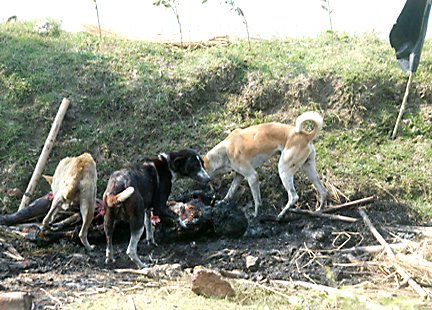
हम एक लोकतंत्र में रह रहे हैं! 14 मार्च को हुई घटना और उसके बाद सीपीएम के बंद के दौरान गायब हुए दो सौ लोगों का अब तक कोई अता-पता नहीं है्. हां। कुछ लाशें हैं जो इलाके में इस हालत में पायी गयी हैं. क्या हम बता सकते हैं कि इन्होंने किस बात की कीमत चुकायी? क्या हम इसको लेकर आश्वस्त रह सकते हं कि हमें भी कभी ऐसी ही कीमत नहीं चुकानी पड़ेगी?
Wednesday, April 25, 2007
Subscribe to:
Post Comments (Atom)
नंदीग्राम पर नयी फ़िल्म
यह फ़िल्म 14 मार्च की घटनाओं के सूक्ष्म विवरण के साथ आयी है.
देखें : नव उदारवाद का नया चेहरा बजरिये नंदीग्राम
देखें : विकास के नाम पर लोगों के उजड़ने की कहानी
उन्होंने मेरे पिता को टुकडों में काट डाला
देखें : न हन्यते
नंदीग्राम में 100 से ज्यादा लोग मारे गये हैं, 200 अब भी लापता हैं. वहां महिलाओं के साथ सीपीएम के कैडरों ने बलात्कार किया. बच्चों तक को नहीं छोड़ा गया है. सीपीएम की इस क्रूरता और निर्लज्जता का विरोध होना चाहिए. हमें नंदीग्राम, सिंगूर और हर उस जगह के किसानों के आंदोलन का समर्थन करना चाहिए, जो अपनी जमीन बचाने के लिए लड़ाई लड़ रहे हैं. यह दस्तावेज़ी फ़िल्म किसानों के इसी संघर्ष के बारे में है. यह फ़िल्म नंदीग्राम के ताज़ा नरसंहार से पहले बनायी गयी थी.
नंदीग्राम में जनसंहार के बाद के द्श्य
यह फिल्म पुलिस द्वारा नंदीग्राम में बर्बर तरीके से की गयी हत्याओं एवं उनकी भयावहता व बर्बरता के बारे में है. इसके कई दृ़श्य विचलित कर देनेवाले हैं.
नंदीग्राम प्रतिरोध्
नंदीग्राम में सरकारी आतंक
देखें : माकपा की गुंडागर्दी
नंदीग्राम में सीपीएम सरकार की पुलिस ने जो बर्बर कार्रवाई की, वह अब खुल कर सामने आने लगी है. यह फ़िल्म उसी बर्बरता के बारे में है. इसके कई दृश्य आपको विचलित कर सकते हैं. आप इसे तभी देखें जब आप वीभत्स दृश्य देख सकने की क्षमता रखते हों. हम खुद शर्मिंदा हैं कि हमें ऐसे दृश्य आपको दिखाने पड़ रहे हैं, पर ये आज की हकीकत हैं. इनसे कैसे मुंह मोडा़ जा सकता है?


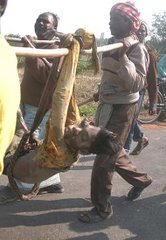
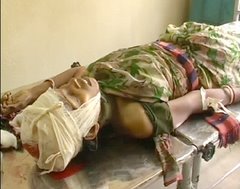

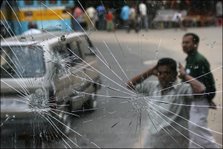
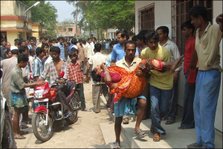




No comments:
Post a Comment